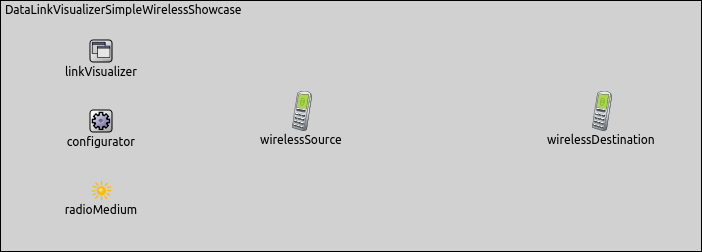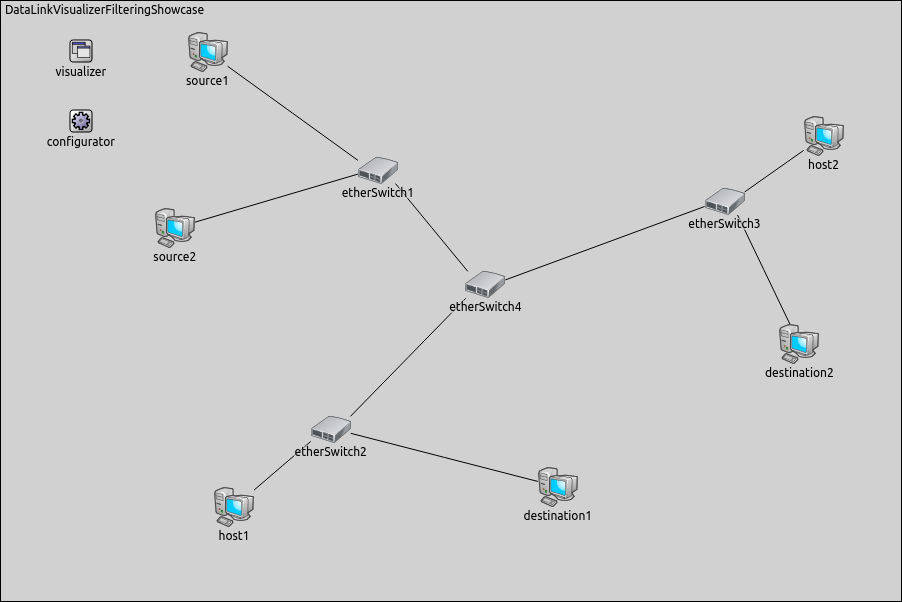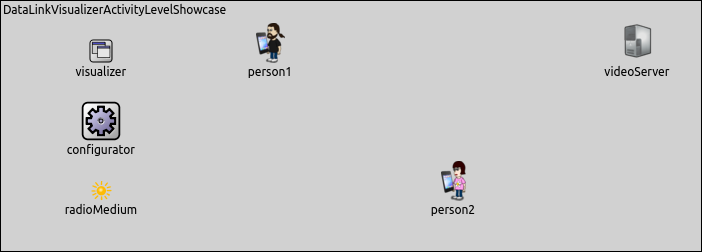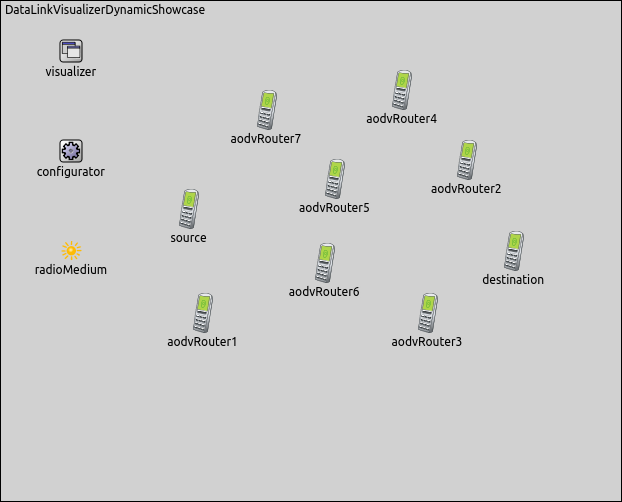Visualizing Data Link Activity¶
Goals¶
Visualizing network traffic is an important aspect of running simulations. INET provides various visualizers to help you understand the network activity, including DataLinkVisualizer which focuses on the data link level. This module allows you to see the visual representation of the data link level traffic in the form of arrows that fade as the traffic ceases.
This showcase features five different simulation models, each designed to demonstrate different capabilities of the data link activity visualizer.
4.0About the Visualizer¶
In INET, data link activity can be visualized by including a
DataLinkVisualizer module in the simulation. Adding an
IntegratedVisualizer module is also an option because it also
contains a DataLinkVisualizer module. Data link visualization is
disabled by default; it can be enabled by setting the visualizer’s
displayLinks parameter to true.
DataLinkVisualizer can observe packets at service, peer
and protocol level. The level where packets are observed can be set by
the activityLevel parameter.
At service level, those packets are displayed which pass through the data link layer (i.e. carry data from/to higher layers).
At peer level, the visualization is triggered by those packets which are processed inside the link layer in the source node and processed inside the link layer in the destination node.
At protocol level, DataLinkVisualizer displays those packets which are going out at the bottom of the link layer in the source node and going in at the bottom of the link layer in the destination node.
The activity between two nodes is represented visually by an arrow that points from the sender node to the receiver node. The arrow appears after the first packet has been received, then gradually fades out unless it is refreshed by further packets. The style, color, fading time and other graphical properties can be changed with parameters of the visualizer.
By default, all packets, interfaces, and nodes are considered for the
visualization. This selection can be narrowed to certain packets and/or
nodes with the visualizer’s packetFilter, interfaceFilter, and
nodeFilter parameters.
Enabling Visualization of Data Link Activity¶
The following example shows how to enable the visualization of data link
activity, and what the visualization looks like. In the first example,
we configure a simulation for a wired network. The simulation can be run
by choosing the EnablingVisualizationWired configuration from the
ini file.
The wired network contains two StandardHost’s, wiredSource and
wiredDestination. The linkVisualizer module’s type is
DataLinkVisualizer.
In this configuration, wiredSource pings wiredDestination. Data
link activity visualization is enabled by setting the displayLinks
parameter to true.
*.linkVisualizer.*.displayLinks = true
The following video shows what happens when the simulation is started.
At the beginning of the video, a red strip appears and moves from
wiredSource to wiredDestination. This strip is the standard
OMNeT++ animation for packet transmissions and has nothing to do with
DataLinkVisualizer. When the packet is received in whole by
wiredDestination (the red strip disappears), a dark cyan arrow is
added by DataLinkVisualizer between the two hosts, indicating data
link activity. The packet’s name is also displayed on the arrow. The
arrow fades out quickly because the fadeOutTime parameter of the
visualizer is set to a small value.
Visualization in a wireless network is very similar. Our next example is
the wireless variant of the above simulation. In this network, we use two
AdhocHost’s, wirelessSource and wirelessDestination. The
traffic and the visualization settings are the same as the configuration
of the wired example. The simulation can be run by choosing the
EnablingVisualizationWireless configuration from the ini file.
The following animation depicts what happens when the simulation is run.
This animation is similar to the video of the wired example (apart from an extra blue dotted line which can be ignored, as it is also part of the standard OMNeT++ packet animation.) Note, however, that the ACK frame does not activate the visualization because ACK frames do not pass through the data link layer.
Filtering Data Link Activity¶
In complex networks with many nodes and several protocols in use, it is
often useful to be able to filter network traffic and visualize only
the part of the traffic we are interested in. The following example
shows how to set packet filtering in DataLinkVisualizer. This
simulation can be run by choosing the Filtering configuration from
the ini file.
We use the following network for this showcase.
This network consists of four switches (etherSwitch1..etherSwitch4)
and six endpoints: two source hosts (source1, source2), two
destination hosts (destination1, destination2) and two other
hosts (host1, host2) which are inactive in this simulation.
Source1 pings destination1, and source2 pings
destination2.
For this network, the visualizer’s type is IntegratedVisualizer.
Data link activity visualization is filtered to display only ping
messages. The other packets, e.g. ARP packets, are not visualized by
DataLinkVisualizer. We adjust the fadeOutMode and the
fadeOutTime parameters so that the activity arrows do not fade out
completely before the next ping messages are sent.
We use the following configuration for the visualization.
*.visualizer.*.dataLinkVisualizer.displayLinks = true
*.visualizer.*.dataLinkVisualizer.fadeOutMode = "simulationTime"
*.visualizer.*.dataLinkVisualizer.fadeOutTime = 1.4s
*.visualizer.*.dataLinkVisualizer.packetFilter = "ping*"
The following animation shows what happens when we start the simulation.
You can see that although there is both ARP and ping traffic in the
network, DataLinkVisualizer only takes the latter into account, due
to the presence of the packetFilter parameter.
It also is possible to filter for network nodes. For the following
example, let’s assume we want to display traffic between the hosts
source1 and destination1 only, along the path etherSwitch1,
etherSwitch4, and etherSwitch2. To this end, we set the
visualizer’s nodeFilter parameter by using the following line (note
the curly brace syntax used for specifying numeric substrings).
*.visualizer.*.dataLinkVisualizer.nodeFilter = "source1 or etherSwitch{1,2,4} or destination1"
It looks like the following when we run the simulation:
As you can see, visualization allows us to follow the ping packets
between source1 and destination1. Note, however, that ping
traffic between the two other hosts, source2 and destination2,
also activates the visualization on the link between etherSwitch1
and etherSwitch4.
Displaying Data Link Activity at Different Levels¶
The following example demonstrates, how to visualize data link activity
at protocol, peer and service level. This simulation can be run by
selecting the ActivityLevel configuration from the ini file.
We use the following wireless network for this example.
The network consists of three AdhocHost nodes: person1, person2,
and videoServer. VideoServer will be streaming a video to
person1. Person2 will be inactive in this example.
The type of the visualizer module is IntegratedMultiVisualizer. Multi-visualizers are compound visualizer modules containing submodule vectors of visualizer simple modules. By default, the multi-visualizers contain one submodule of each visualizer simple module. The number of submodules can be specified with parameters for each visualizer submodule.
In this example, data link activity will be displayed at three different
levels. To achieve this, three DataLinkVisualizer will be
configured, observing packets at service, peer and protocol level.
They are marked with different colors. The visualizer module is
configured as follows.
*.visualizer.*.numDataLinkVisualizers = 3
*.visualizer.*.dataLinkVisualizer[*].displayLinks = true
*.visualizer.*.dataLinkVisualizer[*].packetFilter = "*Video*"
*.visualizer.*.dataLinkVisualizer[*].fadeOutMode = "animationTime"
*.visualizer.*.dataLinkVisualizer[*].holdAnimationTime = 1s
*.visualizer.*.dataLinkVisualizer[0].activityLevel = "protocol"
*.visualizer.*.dataLinkVisualizer[0].lineColor = "purple"
*.visualizer.*.dataLinkVisualizer[0].labelColor = "purple"
*.visualizer.*.dataLinkVisualizer[1].activityLevel = "peer"
*.visualizer.*.dataLinkVisualizer[1].lineColor = "blue"
*.visualizer.*.dataLinkVisualizer[1].labelColor = "blue"
*.visualizer.*.dataLinkVisualizer[2].activityLevel = "service"
*.visualizer.*.dataLinkVisualizer[2].lineColor = "green"
*.visualizer.*.dataLinkVisualizer[2].labelColor = "green"
By using the numDataLinkVisualizers parameter, we set three
DataLinkVisualizer modules. In this example, we are interested in
video packets. To highlight them, we use the packetFilter
parameter. The fadeOutMode parameter specifies that inactive links
fade out in animation time. The holdAnimationTime parameter stops
the animation for a while, delaying the fading of the data link activity
arrows. The activityLevel, lineColor and labelColor
parameters are different at each DataLinkVisualizer to make data
link activity levels easy to distinguish:
dataLinkVisualizer[0]is configured to display protocol level activity with purple arrows.dataLinkVisualizer[1]is configured to display peer level activity with blue arrows,dataLinkVisualizer[2]is configured to display service level activity with green arrows,
The following video shows what happens when the simulation is running.
At the beginning of the video, person1 sends a VideoStrmReq
packet, requesting the video stream. In response to this,
videoServer starts to send video stream packet fragments to
person1. The packets are fragmented because their size is greater
than the Maximum Transmission Unit. The first packet fragment,
VideoStrmPk-frag0 causes data link activity only at protocol level
and at peer level, because other packet fragments are required to
allow the packet to be forwarded to higher layers. When
VideoStrmPk-frag1 is received by person1, the packet is
reassembled in and is sent to the upper layers. As a result of this, a
green arrow is displayed between videoServer and person1,
representing data link activity at service level.
Another phenomenon can also be observed in the video. There is
protocol-level data link activity between person2 and the other
nodes. This activity is because frames are also received in the physical layer
of person2, but they are dropped at the data link layer level because
they are not addressed to person2.
Visualizing Data Link Activity in a Mobile Ad-Hoc Network¶
The following simulation shows how visualization can help you to follow
dynamically changing data link activity in a wireless environment. The
simulation can be run by choosing the Dynamic configuration from the
ini file.
We use the following network for this simulation:
Nodes are of the type AodvRouter, and are placed randomly on the
scene. The communication range of the nodes is chosen so that the
network is connected, but nodes can typically only communicate by using
multi-hop paths. The nodes will also randomly roam within predefined
borders. The routing protocol is AODV. During the simulation, the
source node will be pinging the destination node.
In our first experiment, the goal is to visualize the operation of the
AODV protocol as it sets up a route from source to destination.
We expect to see the following. As long as source has a valid route
towards destination, AODV is inactive. When a new route is needed
towards destination, source starts to flood the network with
AODV route request (RREQ) messages. RREQ messages propagate through the
intermediate nodes until one of them reaches the destination node.
The route is made available by unicasting AODV route reply (RREP)
messages back to the originator of the RREQ messages. Reception of the
RREP message in each host results in the node updating its routing table
with the next hop address towards the destination node.
As AODV operates with two message types, we’ll use two DataLinkVisualizer modules configured to use two different colors.
*.rreqVisualizer.*.displayLinks = true
*.rreqVisualizer.*.packetFilter = "AodvRreq"
*.rreqVisualizer.*.fadeOutMode = "simulationTime"
*.rreqVisualizer.*.fadeOutTime = 0.002s
*.rrepVisualizer.*.displayLinks = true
*.rrepVisualizer.*.packetFilter = "AodvRrep"
*.rrepVisualizer.*.fadeOutMode = "simulationTime"
*.rrepVisualizer.*.fadeOutTime = 5s
*.rrepVisualizer.*.lineColor = "blue"
*.rrepVisualizer.*.labelColor = "blue"
The following video has been captured from the simulation, and allows us
to observe the AODV protocol in action. The dark cyan arrows indicate
RREQ packets which flood the network. When an RREQ message reaches
destination, destination sends an RREP message (blue arrow) back
towards source. Note that nodes appear stationary because the whole
process takes place in a very short time period.
In the second experiment, we configure the visualizer to display only
the ping traffic between source and destination. (The AODV
visualizers will be disabled.) We’ll simulate a longer time period so
that nodes move around in the scene, forcing AODV to find new
routes from time to time.
We use the following configuration for the visualization.
*.visualizer.*.dataLinkVisualizer.displayLinks = true
*.visualizer.*.dataLinkVisualizer.packetFilter = "ping*"
*.visualizer.*.dataLinkVisualizer.fadeOutMode = "simulationTime"
*.visualizer.*.dataLinkVisualizer.fadeOutTime = 5s
The following animation illustrates what happens when the simulation is run.
The communication ranges of source and destination are
visualized as blue circles.
The video clearly shows the route ping packets are taking between
source and destination. Visualization is triggered by the ping
packets being sent up from the data link layer (wireless interface) of
the receiver node to the network layer (IPv4), where they are routed
towards the next hop.
When the existing route breaks due to two nodes drifting away (out of the communication range of each other), this manifests as a link-level failure (ACK frames do not arrive). This condition is detected by AODV, and it starts searching for a new route. When the new route is found, the ping traffic resumes.
We can observe in the video that the route the ping packets take is not always optimal (in terms of hop count). The reason is that nodes use an existing route as long as possible, even when a shorter route becomes available as a result of node movement. AODV is only activated when the existing route breaks.
Sources: omnetpp.ini, DatalinkVisualizerShowcase.ned
More Information¶
This example only demonstrates the key features of data link activity
visualization. For more information, refer to the DatalinkVisualizer
NED documentation.
Try It Yourself¶
If you already have INET and OMNeT++ installed, start the IDE by typing
omnetpp, import the INET project into the IDE, then navigate to the
inet/showcases/visualizer/canvas/datalinkactivity folder in the Project Explorer. There, you can view
and edit the showcase files, run simulations, and analyze results.
Otherwise, there is an easy way to install INET and OMNeT++ using opp_env, and run the simulation interactively.
Ensure that opp_env is installed on your system, then execute:
$ opp_env run inet-4.0 --init -w inet-workspace --install --chdir \
-c 'cd inet-4.0.*/showcases/visualizer/canvas/datalinkactivity && inet'
This command creates an inet-workspace directory, installs the appropriate
versions of INET and OMNeT++ within it, and launches the inet command in the
showcase directory for interactive simulation.
Alternatively, for a more hands-on experience, you can first set up the workspace and then open an interactive shell:
$ opp_env install --init -w inet-workspace inet-4.0
$ cd inet-workspace
$ opp_env shell
Inside the shell, start the IDE by typing omnetpp, import the INET project,
then start exploring.




